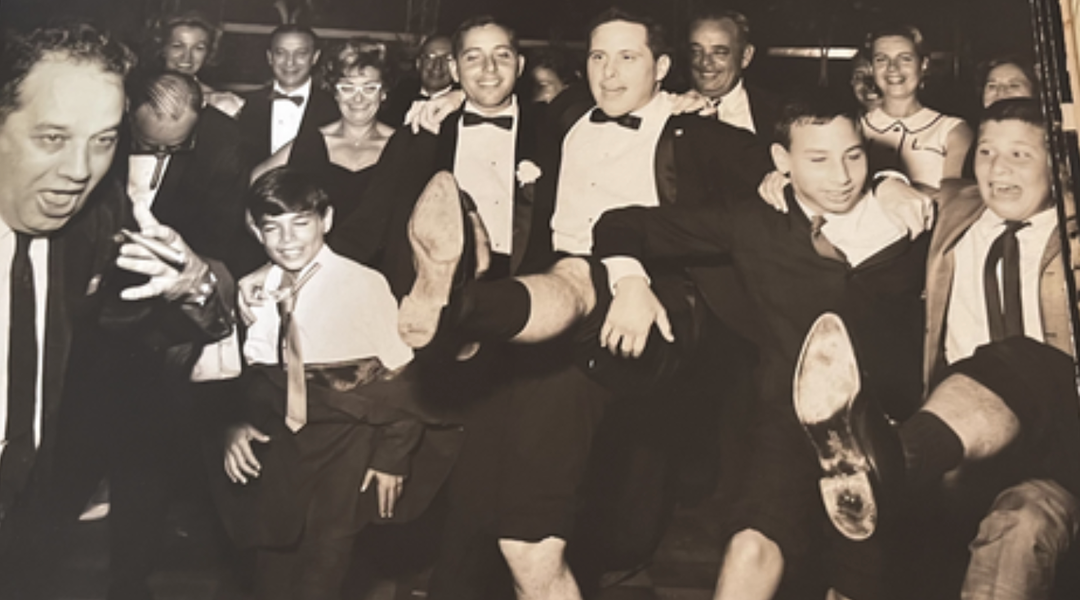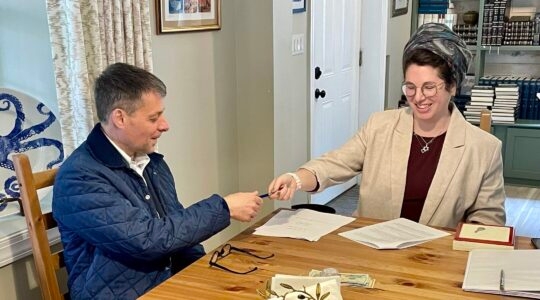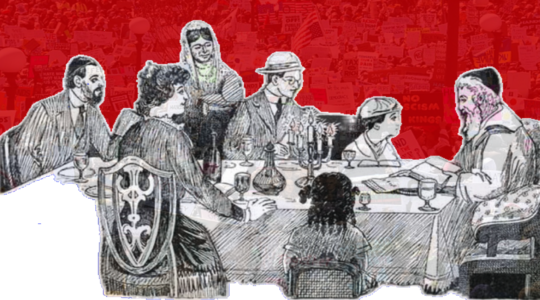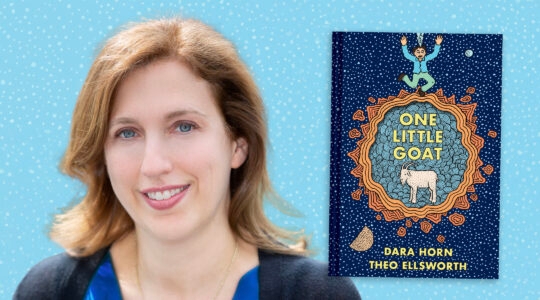(JTA) — When my wife and I were planning our wedding, we thought it might be cool to hire a klezmer band. This was during the first wave of the klezmer revival, when groups like The Klezmatics and The Klezmer Conservatory Band were rediscovering the genre of Jewish wedding music popular for centuries in Yiddish-speaking Eastern Europe.
Of course we also wanted to dance to rock ‘n’ roll and needed musicians who could handle Sinatra for our parents’ benefit, so we went with a more typical wedding band. Modernity won out over tradition.
Or did it? Musician and musicologist Uri Schreter argues that the music heard at American Jewish weddings since the 1950s has become a tradition all its own, especially in the way Old World traditions coexist with contemporary pop. In a dissertation he is writing about the politics of Jewish music in the early postwar period, Schreter argues that American Jewish musical traditions — especially among secularized Conservative and Reform Jews — reflect events happening outside the wedding hall, including the Holocaust, the creation of Israel and the rapid assimilation of American Jews.
That will be the subject of a talk he’ll be giving Monday for YIVO, titled “Yiddish to the Core: Wedding Music and Jewish Identity in Postwar New York City.”
Because it’s June — and because I’m helping plan a wedding for one of my kids one year from now — I wanted to speak to Schreter about Jewish weddings and how they got that way. Our Zoom conversation Wednesday touched on the indestructibility of the hora, the role of musicians as “secular clergy” and why my Ashkenazi parents danced the cha-cha-cha.
Born in Tel Aviv, Schreter is pursuing his PhD in historical musicology at Harvard University. He is a composer, pianist and film editor.
Our conversation was edited for length and clarity.
I was struck by your research because we’re helping to plan a child’s wedding now. It’s the first wedding we’ve planned since our own, and we’re still asking the same questions, like, you’ve got to make sure the band can handle the hora and the Motown set and, I don’t know, “Uptown Funk.” Your research explores when that began — when American Jewish weddings began to combine the traditional and secular cultures.
In the period that I’m talking about, post-World War II America, this is already a fact of life for musicians. A lot of my work is based on interviews with musicians from that period, folks now in their 80s and 90s. The oldest one I have started playing professionally in 1947 or ’48. Popular American music was played at Jewish weddings as early as the 1930s, but it’s a question of proportion — how much the wedding would feature foxtrots and swing and Lindy Hop and other popular dance tunes of the day, and how much of it is going to be klezmer music.
In the postwar period, most of the [non-Orthodox] American Jewish weddings would have featured American pop. For musicians who wanted to be in what they called the “club date” business, they needed to be able to do all these things. And some “offices” — a term they used for a business that books wedding bands — would have specialists that they could call on to do a Jewish wedding.
You’re writing about a period when the Conservative movement becomes the dominant American Jewish denomination. They have one foot in tradition, and the other in modernity. What does a wedding look like in 1958 when they’re building the big suburban synagogues?
The difference is not so much denominational but between the wide spectrum of Orthodoxy and the diverse spectrum of what I describe as “secular.”
Meaning non-Orthodox — Reform, Conservative, etc.?
Right. Only in the sense that they are broadly speaking more secular than the Orthodox. And if so they are going to have, for the most part, one, maybe two sets of Jewish dance music — basically a medley of a few Jewish tunes. You might have a wedding where it could be a quarter of the music or even half would be Jewish music, but this would be for families that have a much stronger degree of attachment to traditional Jewish culture, and primarily Yiddish culture.
There’s a few interrelated elements that shape this. Class is an important thing. For lower class communities in some areas, and I am talking primarily about New York, you’d have communities that are a little bit more secluded, probably speaking more Yiddish at home and hanging out more with other Jewish people from similar backgrounds. So these kinds of communities might have as much as a third or half of the music be Jewish, even though they consider themselves secular. It’s actually very similar to an Orthodox wedding, where you might also have half and half [Jewish and “American” music].
Jews in the higher socioeconomic class might, in general, be more Americanized, and want to project a more mainstream American identity. They might have as little as five minutes of Jewish music, just to mark it that they did this. Still, it’s very important for almost all of them to have those five minutes — because it’s one of the things that makes the wedding Jewish. I interviewed couples that were getting married in the ’50s, and a lot of them told me, “You need to have Jewish dance music for this to be a Jewish wedding.”

Composer and pianist Uri Schreter is pursuing his PhD in historical musicology at Harvard University. (Nicole Loeb)
When I was growing up in the 1970s at a suburban Reform synagogue on Long Island, klezmer was never spoken about. I don’t know any parents who owned klezmer albums. Then when I got married a decade later, it was in the middle of the klezmer revival. Am I right about that? Were the ’50s and ’60s fallow periods for klezmer?
You’re definitely right. Up until the mid-1920s, you still have waves of immigration coming from Eastern Europe. So you still have new people feeding this desire for the traditional culture. But as immigration stops and people basically tried to become American, the tides shift away from traditional klezmer.
The other important thing that happens in the period that I’m looking at is both a negative rejection of klezmer and a positive attraction to other new things. Klezmer becomes associated with immigrant culture, so people who are trying to be American don’t want to be associated with it. It also becomes associated with the Holocaust, which is very problematic. Anything sounding Yiddish becomes associated for some people with tragedy.
At the same time, and very much related to this, there’s the rise of Israeli popular culture, and especially Israeli folk songs. A really strong symbol of this is in the summer of 1950, when the Weavers record a song called “Tzena, Tzena,” a Hebrew Israeli song written in the 1940s which becomes a massive hit in America — it’s like number two in the Billboard charts for about 10 weeks. Israeli culture becomes this symbol of hope and the future and a new society that’s inspiring. This is all in very stark contrast to what klezmer represents for people. And a lot of the composers of Israeli folk song of its first decades had this very clearly stated ideology that they’re moving away from Ashkenazi musical traditions and Yiddish.
So the Jewish set at a wedding becomes an Israeli set.
At a typical Conservative wedding in the 1950s and ’60s, you might hear 10 minutes of Jewish music. The first one would be “Hava Nagila,” then they went to “Tzena, Tzena,” then they would do a song called “Artza Alinu,” which is today not very well known, and then “Hevenu Shalom Aleichem.” They are songs that are perceived to be Israeli folk songs, even though if you actually look at their origins, it’s a lot murkier than that. Like two of the songs I just mentioned are actually Hasidic songs that received Hebrew words in pre-state Palestine. Another probably comes from some sort of German, non-Jewish composer in 1900, but is in Hebrew and is perceived to be a representation of Israeli culture.
But even when the repertoire already represents a shift towards what’s easier to digest for American Jewry, the arrangements and the instruments and the musical ornamentation are essentially klezmer. The musicians I spoke to said they did this because they felt that this is the only way that it would actually sound Jewish.
That is to say, to be “Jewish” the music had to gesture towards Ashkenazi and Yiddish, even if it were Israeli and Hebrew. As if Jews wanted to distance themselves from Eastern Europe — but only so far.
Someone like Dave Tarras or the Epstein Brothers, musicians who were really at the forefront of klezmer in New York at the time, were really focused on bringing it closer to Ashkenazi traditions. Ashkenazi Jewish weddings in America are not the totality of Jewish weddings in America, and Israeli music itself is made up of all these different traditions — North African, Middle Eastern, Turkish, Greek — but in effect most of the really popular songs of the time were composed by Ashkenazi composers. Even “Hava Nagila” is based on a melody from the Sadigura Hasidic sect in Eastern Europe.
Of course, if you’re a klezmer musician you’re allergic to “Hava Nagila.”

Then-Vice President Joe Biden dances the hora with his daughter Ashley at her wedding to Howard Krein in Wilmington, Delaware on June 2, 2012. (White House/David Lienemann)
You spoke earlier about Latin music, which seemed to become a Jewish thing in the 1950s and ’60s — I know a few scholars have focused on Jews and Latinos and how Latin musical genres like the mambo and cha-cha-cha became popular in the Catskill Mountain resorts and at Jewish weddings.
Latin music is not exclusively a Jewish thing, but it’s part of American popular culture by the late 40s. But Jews are very eagerly adopting it for sure. In the Catskills, you would often have two separate bands that alternated every evening. One is a Latin band, one is a generic American band playing everything else. And part of that is American Jews wanting to become American. And how do you become American? By doing what Americans do: by appropriating “exotic” cultures, in this case Latin. This is a way of being American.
Jews and Chinese food would be another example.
And by the way, in a similar vein, it also becomes very popular to dance to Israeli folk songs. A lot of people are taking lessons. A lot of people are going to their Jewish Y to learn Israeli folk dance.
I’ve been to Jewish weddings where the “Jewish set” feels very perfunctory — you know, dance a hora or two long enough to lift the couple on chairs and then let’s get to the Motown. Or the Black Eyed Peas because they were smart enough to include the words “Mazel Tov!” in the lyrics to “I Gotta Feeling.”
So that’s why we always hear that song! I will say though, even when the Jewish music appears superficial, it does have this deeper layer of meaning. It’s very interesting how, despite all these changes, and despite the secularization process of American Jewish weddings, the music still connects people to their Jewishness. These pieces of music are so meshed with other religious components. Of course, most people see this as secular. But a lot of people connect to their Jewish identity through elements such as Jewish music, Jewish food, certain Jewish customs that are easier to accommodate in your secular lifestyle, and the music specifically has this kind of flexibility, this fluidity between the sacred and the profane.
That’s beautiful. It sort of makes the musicians secular clergy.
It’s interesting that you say that. In his history of klezmer, Walter Zev Feldman refers to the klezmer — the word itself means “musician” — as a kind of a liminal character, an interstitial character between the secular and the mundane. The music is not liturgical, but when the klezmer or the band is playing, it is an interval woven with all these other religious components and things that have ritual meaning.
JTA has documented Jewish history in real-time for over a century. Keep our journalism strong by joining us in supporting independent, award-winning reporting.







